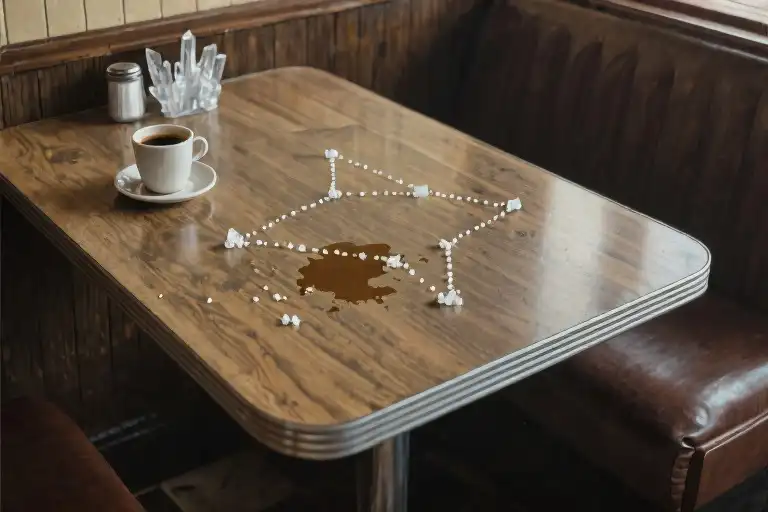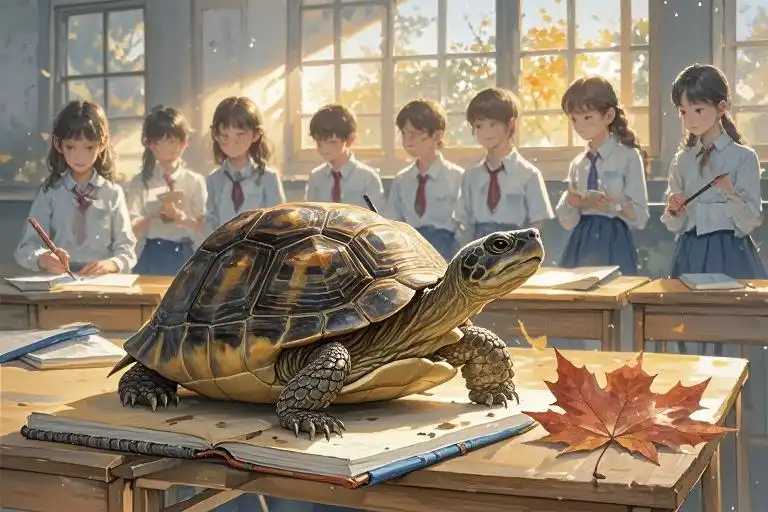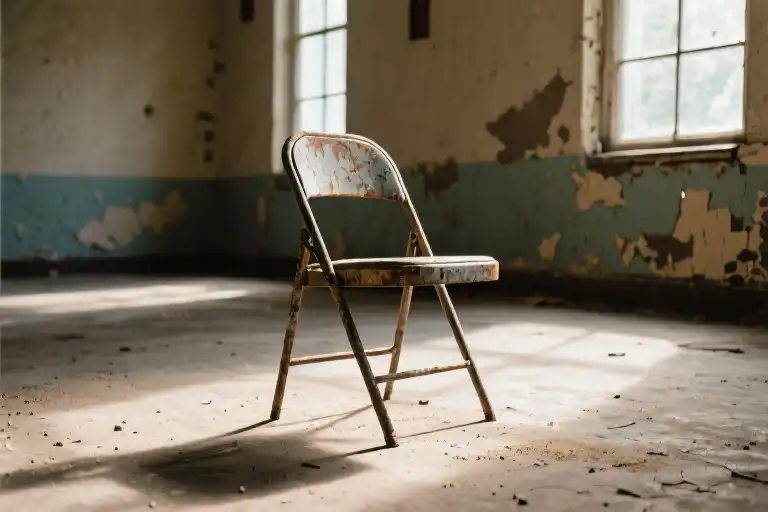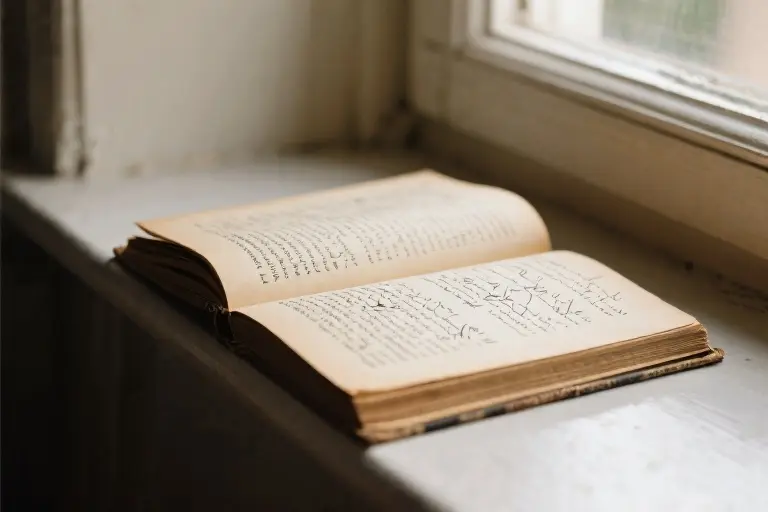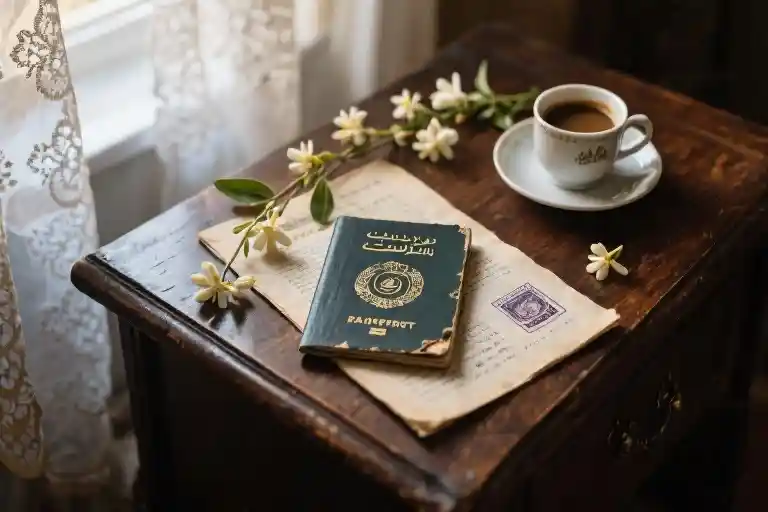The coffee cup leaves a perfect ring on the wooden table, its edges still trembling slightly. Through the diner’s window, afternoon light fractures around a silhouette—a man leaning forward, his glasses catching the sun as his lips form the question for the third time: “Who are you?”
My fingers trace the damp edge of a cloth nearby, the same one that smeared my unfinished answer on the dry-erase board this morning. The letters blur where I’ve erased too hard: I was—
I think—
I don’t—
Three attempts, three evaporating identities. The board’s surface holds the ghost of every answer I couldn’t commit to, like tide lines on sand. Outside, a gull cries—a sound that could be laughter or warning.
Existential writing begins here, in this suspended moment between question and evaporation. The man’s posture suggests he’s accustomed to leaning into discomfort—elbows on table, shoulders hunched forward like a bridge. When I say runner, his exhale fogs his glasses. When I say writer, he taps his temple twice, leaving a fingerprint on the lens. The third silence stretches until the espresso machine hisses, and suddenly we’re both staring at the salt shaker he’s knocked over, grains scattering like tiny meteors across formica.
This is how identity crisis feels: not as a thunderclap, but as the slow seep of coffee through a napkin. The dry-erase marker squeaks when I test it again on my wrist—still alive, still willing to translate the unsayable. Nearby, the waitress refills a stranger’s cup, her movements precise as a ritual. I imagine writing her story instead: She was someone who knew the exact angle to pour without spilling.
The cloth in my hand smells of lemon and mildew, a combination that inexplicably recalls my grandmother’s kitchen. For a dangerous second, I consider writing jam-maker on the board. But the man is standing now, his shadow falling across the salt-strewn table. “Try answering sideways,” he suggests, and for the first time I notice his shoes—scuffed at the toes, as if he’s been kicking at something invisible.
When the door jingles shut behind him, I press my palm to the coffee ring. The stain transfers to my skin, temporary as a birthmark. On the board, my reflection floats over the smudged words. The gull cries again. Somewhere, a window is being cleaned with meticulous care, stroke after stroke after stroke.
The Divination of Salt
The words sat crooked on the page, each letter drifting 0.5mm northeast of where it should be. ‘Who are you’ appeared three times in staggered formation, the ink bleeding slightly at the edges where my fingers had smudged the dry erase board. The man’s glasses caught the café lighting at such an angle that his eyes disappeared behind white reflections when he asked the question for the third time.
Between us, a spilled salt shaker painted constellations on the tabletop. Modern divination: the crystals formed Orion’s belt near my coffee cup, Cassiopeia’s chair by his abandoned notebook. I traced the patterns with a damp fingertip, remembering how grandmother used to toss salt over her shoulder when canning summer fruit – superstitious protection against spoiled preserves.
‘Runner,’ I’d said first. The word tasted of sweat and pavement. ‘Writer,’ second attempt, syllables sticking like cheap printer paper. The third silence stretched long enough for the espresso machine to hiss twice behind the counter. His chair scraped backward in sudden retreat, coming to rest at a perpetual 15-degree tilt that no busboy would ever fully correct.
What alchemy transforms table salt into meaning? The grains still glitter where they fell, mapping uncharted territory between his empty espresso cup and my unfinished answer. I press one crystal to my tongue – the burn of seawater without the vastness. Some questions scatter like this, leaving only faint stellar patterns and the metallic aftertaste of not-knowing.
Through the window, afternoon light bends around the forever-tilted chair. A cleaner approaches with rag and spray bottle, hesitates before this modern artifact. For three breaths we both study the salt constellations, their cosmic joke written in minerals and absence. Then her cloth sweeps across the formica, dissolving Orion into damp streaks. The chair remains angled, a monument to interrupted conversations.
My fingers find the dry erase marker in my pocket. On the board’s smudged surface, I redraw the question in careful block letters, watching ink displace the ghost of previous attempts. The letters align perfectly this time, marching straight across the white plane. Yet when I step back, the entire phrase appears to lean slightly left, as if pulled by some invisible planetary gravity.
The Intertidal Electrocardiogram
The boardwalk creaks underfoot with each retreating wave, its weathered planks keeping time like an erratic metronome. I count the rhythm between surges—three seconds, five, two—until the intervals blur into my own pulse. At high tide, the ocean breathes in perfect sync with me; at low tide, I’m left gasping on the exposed shoreline of myself.
Between the land and sea, this liminal space collects artifacts. Tiny barnacles colonize the wooden seams, building their calcium cathedrals in the gaps where nails have rusted away. I run my fingers over their ridged domes, wondering what psalms they chant when the water returns. Their existence depends on neither solid ground nor open ocean, but the constant negotiation between both.
Yesterday’s storm washed a strand of kelp across the railing. It dangles now like a discarded stethoscope, its bladders popping softly in the sun. When I press it to my chest, the saltwater heartbeat matches mine exactly. The diagnosis is simple: we’re all just temporary vessels holding the same ancient tides.
Three words have taken residence behind my molars since the encounter. ‘Stay’ sits largest, wedged sideways near the wisdom tooth. Each time I test its edges with my tongue, I taste copper and unfinished conversations. The man’s questions continue eroding my defenses, wave after wave, until I’m nothing but smooth stones and sea glass.
At dusk, the boardwalk transforms into a soundboard. Footsteps resonate hollow promises, while the gulls’ cries stitch the horizon to the sky. I measure the distance between what I was, what I am, and what the currents keep suggesting I could be. The math never balances—there’s always one variable missing, one confession stuck in my teeth like a fishbone.
When the moonlight paints silver EKG lines across the water, I finally understand: identity isn’t a shoreline to claim, but the perpetual motion where sea meets land. The barnacles know this truth in their calcified hearts. They grow where the waves can’t keep them, but never dry out completely. Perhaps that’s the proper pacing—not resisting the tides, but learning when to hold on and when to let the current carry you.
My fingers trace the growth rings on the railing, counting the winters when storms tried to dismantle this structure. The wood remembers every impact, every repair. It occurs to me that we’re all just boardwalks over some churning depth, half-drowned and half-alive, waiting for the next wave to redefine our edges.
The Archaeology of Glass
The windows in my front room hold more than fingerprints and dust. With cotton swabs dipped in vinegar solution, I begin excavating the layers—removing last week’s rain streaks, last month’s pollen dust, until my fingers brush against something older. The window frames still wear their original WWII-era paint, that peculiar shade of government-issue green now crackling like ancient parchment beneath my touch.
Between the double panes, a single strand of hair catches the morning light. It’s hers—the way it curls at the end where it used to brush against her collarbone. The glass has preserved it perfectly, suspended in that narrow vacuum where time doesn’t move forward or backward. I press my forehead against the cool surface, watching how the strand trembles when trucks pass on the street below.
At precisely 11:07, a diamond-shaped light spot appears on the eastern window. No amount of Windex or newspaper scrubbing removes it. The optometrist called it ‘visual snow’ when I described it last year, but I know better. It’s the exact size and shape of the pendant she wore on our first date, that cheap zirconium thing that caught the café lights every time she laughed.
Cleaning becomes forensic work:
- Document stains with morning light at 45-degree angles
- Categorize smudges by probable origin (child fingerprints vs. dog nose prints)
- Preserve organic matter in the window track grooves
The glass tells stories in layers. Yesterday’s condensation evaporates to reveal last winter’s ghostly breath patterns. A faint heart shape drawn by some previous tenant lingers in the corner, surviving three deep cleanings. Through this transparent barrier, the apple tree in the yard appears warped—its branches bending at odd angles where the glass imperfections magnify certain leaves.
Sometimes I catch myself speaking to my reflection in the glass, repeating that same unanswered question. The windows give nothing back except my own distorted face, slightly wider than reality, with eyes that seem to float half an inch too high. At night, when the glass turns black, I trace the path of her hair strand with my fingertip, feeling the vibration of car stereos through the pane.
This ritual has rules:
- Never clean when angry (the streaks become permanent)
- Always move in clockwise circles (counterclockwise invites memories)
- Breathe through your nose (the vinegar smell keeps you present)
The diamond light spot vanishes at 11:09, taking with it the afterimage of that zirconium pendant. I’m left with ordinary glass again—just silica and soda ash, just sand that forgot how to flow. The cotton swab in my hand has unraveled, leaving white fibers caught in the window track like miniature ghosts. Outside, the apple tree’s shadow stretches across the newly cleaned pane, its branches now holding not birds but fragments of my reflection.
Jam Cosmology
The copper pot sat heavy on the stove, its concave belly cradling constellations of burnt sugar – a carbonized Milky Way swirling beneath layers of raspberry and time. This was my grandmother’s alchemy lab, where summer afternoons condensed into jewel-toned preserves. I measure my existence in the weight of a robin perched on her hydrometer: 3.2 grams of equilibrium between syrup and sky.
Memory works like unsealed mason jars in the pantry. What we fail to properly preserve ferments unpredictably – childhood summers morphing into vinegar-sharp recollections, the sweetness of her apron pockets now laced with the tannic aftertaste of loss. She taught me the wrinkle test: when the jam sheet forms peaks that hold their shape, it’s reached 220°F. But how to test the doneness of grief?
Three elements comprised her universe:
- The copper pot (inherited from a great-aunt who died mid-simmer)
- Wooden spoons whittled smooth by decades of clockwise stirring
- The exact moment when sugar transcends its granular nature
I stir counterclockwise now, disrupting the inherited rhythm. The bubbles burst in tiny supernovae, each collapse releasing trapped sunlight from June orchards. Physics claims energy cannot be created or destroyed, yet here in this kitchen, 17 bruised plums transform into something that outlasts both fruit and picker.
The robin at the window cocks its head. It knows what I’m just beginning to understand – identity isn’t found in the boiling, but in the spaces between bubbles. Not in the jar’s seal, but in the sticky fingerprints left on its lid. My grandmother never wrote recipes, yet her hands continue guiding mine through this edible astronomy.
In the cupboard, last year’s experimental batch of quince and star anise quietly carbonates itself. Some transformations refuse to be contained by lids or labels. Like memories, like selves, they expand until the glass cracks or the sweetness finds its own escape.
Your turn: What kitchen artifact holds your personal history? Measure its weight in something unexpected – sparrow feathers, radio waves, the silence between heartbeats.
The Pyramid of Unanswered Questions
The salt pyramid glistens on the windowsill, each crystal holding the weight of unspoken answers. Outside, the shadow of the last bird stretches across the apple tree – a fleeting Rorschach test that could mean everything or nothing at all. The dry erase board exhales its new question in ghostly letters: “when are you”.
The Alchemy of Ordinary Things
Morning light transforms the salt grains into miniature prisms, refracting all the versions of myself I’ve claimed to be:
- The runner (knees now remembering every pavement)
- The writer (fingers hovering over keys like uncertain birds)
- The man who still startles at his own reflection in freshly cleaned windows
Three layers of meaning emerge from this silent epilogue:
- The Salt Chronicles
Those scattered crystals from the coffee shop encounter have now self-organized into perfect geometry. They whisper about preservation and corrosion, about how we both save and erode ourselves through daily rituals. The pyramid’s slope matches the angle of the mystery man’s retreating shoulders. - Avian Calculus
The bird’s shadow isn’t just absence of light – it’s a living equation. Wingspan versus elapsed time equals the exact duration of my grandmother’s jam-making afternoons. When the shadow touches the ground, I taste copper pans and summer strawberries. - The Board’s Evolution
From “who” to “when” – the question has shed its skin. The letters pulse slightly, keeping rhythm with:
- The dripping faucet in the kitchen
- My carotid artery
- Some distant woodpecker working on its own existential dilemma
The Physics of Transition
This ending isn’t static. Observe the phenomena:
- Phase Change
The salt absorbs humidity, becomes temporary glue holding together: - A receipt from the day I quit running
- The pharmacy slip for my wife’s migraine medication
- One dried apple blossom from the year grandmother died
- Shadow Dynamics
As the bird completes its transit, the shadow performs its final trick:
- Covers the pyramid completely (total eclipse of certainty)
- Flickers like an old film projector (memory frames)
- Leaves behind a feather stuck in tree sap (nature’s post-it note)
- Ergodic Writing
The dry erase marker continues its invisible work: - “when” develops a serif font
- The question mark curls into a fetal position
- The board’s surface temperature drops 2°C
Instructions for the Next Traveler
If you find yourself here:
- Run your finger along the pyramid’s edge (count the layers like tree rings)
- Catch the feather before it petrifies (it weighs exactly one unanswered question)
- Add your own temporal marker to the board (the surface accepts only honest ink)
The window stays clean. The tree keeps bearing fruit. The questions continue their metamorphosis. Somewhere, a copper pot sings on a stove, and for three precise minutes, all chronologies align.

